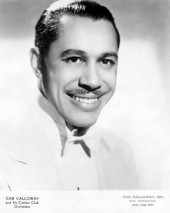Early years
Calloway was born in a middle-class family in Rochester, New York, on Christmas Day in 1907, and raised primarily in Baltimore, Maryland. His father, Cabell Calloway II, was a lawyer, and his mother Martha Eulalia Reed was a teacher and church organist. His parents recognized their son's musical talent, and he began private voice lessons in 1922. He continued to study music and voice throughout his formal schooling. Despite his parents' and vocal teachers' disapproval of jazz, Calloway began frequenting and eventually performing in many of Baltimore's jazz clubs, where he was mentored by the drummer Chick Webb and the pianist Johnny Jones.
After graduating from high school in 1927 Cab joined his older sister Blanche in a touring production of the popular black musical revue "Plantation Days." When the tour ended in Chicago in the fall, Cab decided to remain in Chicago with his sister, who had an established career as a jazz singer in that city. His parents had hopes of their son becoming a lawyer like his father, so Calloway enrolled in Crane College. His main interest, however, was in singing and entertaining, and he spent most of his nights at the Dreamland Cafe and the Sunset Cafe, performing as a drummer, singer and emcee. At the Sunset Cafe he met and performed with trumpeter Louis Armstrong who taught him to sing in the "scat" style.
Forming the Cab Calloway Orchestra
When Louis Armstrong and his band left for New York City in 1929, Calloway dropped out of college and became the leader of the house band at the Sunset Cafe, an 11-piece group called "The Alabamians." He was quickly signed to a deal with MCA (at the time a booking, management and publishing company, not yet a record label) and began a national tour. The tour ended in New York at the Savoy Ballroom, a prestigious jazz club owned by his old friend from Baltimore, Chick Webb. Impressed by Calloway's showmanship and singing, but not very impressed with "The Alabamians", the manager of the Savoy convinced Calloway to become the leader of the Savoy's house band, "The Missourians."
It was during his stint at the Savoy that Calloway truly developed his individual style of showmanship. Wild-haired, with the conk hairdo then popular among black musicians, and dressed in an all-white tuxedo and tails, Calloway introduced audience singalongs, vocal histrionics, snappy song introductions and a wildly extroverted band, all of which made the Cab Calloway Orchestra very popular with New York audiences.
Success
By 1930 the Cotton Club in Harlem had become the premier jazz venue in the country, and the Cab Calloway Orchestra was hired as a replacement for the Duke Ellington Orchestra while they were touring. (There is some speculation that Mafia pressure was responsible for Cab's hiring.) Calloway quickly proved so popular that his band became the "co-house" band with Ellington's, and Cab and his group began touring nationwide when not playing the Cotton Club. Their popularity was greatly enhanced by the twice-weekly live national radio broadcasts on NBC at the Cotton Club. Calloway also appeared on Walter Winchell's radio program and with Bing Crosby in his show at the Paramount Theatre. As a result of these appearances, Calloway, together with Ellington, broke the major broadcast network color barrier.
In 1931, he recorded his most famous song, "Minnie the Moocher". That song and "St. James Infirmary Blues" appeared in the Betty Boop animated shorts Minnie the Moocher and Snow White, respectively. Cab took advantage of this and timed his concerts in some communities with the release of the films in order to make the most of the attention.
Later years
In his later career, Calloway became a popular actor, appearing in a number of films and stage productions that utilized both his acting and singing talents. In 1959, he played the prominent role of "Sportin' Life" in a production of the Gershwin opera Porgy and Bess aside William Warfield and Leontyne Price as the title characters. Another notable role was The Cincinnati Kid (1965), with Steve McQueen and Edward G. Robinson.
In 1967 Calloway co-starred as Horace Vandergelder in an all-black cast Broadway revival of Hello, Dolly! (even though the original production was still running!) starring Pearl Bailey. This was a major success and led to a cast recording released by RCA. In 1973-1974 he was featured in an unsuccessful Broadway revival of The Pajama Game alongside Hal Linden and Barbara McNair.
Calloway attracted renewed interest in 1980 when he appeared as a supporting character in the film The Blues Brothers, performing "Minnie The Moocher" to buy time for the Brothers to make it to their own concert. In 1994, a creative and performing arts school Cab Calloway School of the Arts was dedicated in his his name in Wilmington, Delaware.
